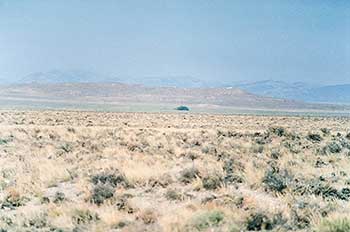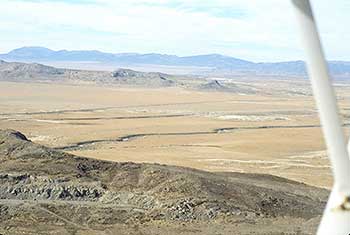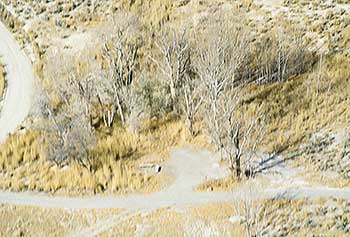September 11, 1841
Continue southwest to the Grouse Creek JUNCTION (14.0 miles). Turn left and follow the southeast unmarked road 1.2 miles to the trees at Owl Springs. This is the 11 SEPTEMBER CAMPSITE. James John described the campsite: "We started early, travelled about 14 miles to the southwest, and found water and grass here and we camped for the night." Our marker here reads:
BIDWELL /BARTLESON TRAIL - OWL SPRINGS
First Overland Emigrant Party
"This morning left two waggons belonging to B. Kelsey, their oxen being worn down by fatigue. They were compelled to leave their waggons and pack their baggage on horses and mules."
James John, September 12, 1841
2000 Utah Crossroads Chapter - OCTA BBU-12
 |
 |
|
After the Bidwell Party rounded the point and headed west, they would see the cottonwood trees at Owl Springs which is the center of this picture.
James John described the campsite for September 11th which was at Owl Springs. "We started early, travelled about 14 miles to the southwest, and found water and grass here and we camped for the night."
The following day, the first wagons were abandoned. John Bidwell wrote: "Mr. Kelsey left his wagons and took his family and goods on pack horses, his oxen not being able to keep up. Distance today, about twelve miles."
James John wrote: "This morning left two wagons belonging to b. Kelsey, their oxen being worn down by fatigue. They were compelled to leave their wagons and pack their belongings on horses and mules."
Charles Kelly in his book Salt Desert Trails claims that: An iron boxing from the wheel of a linch - pin wagon was found at this spring, implying that it was from one of the abandoned Kelsey wagons.
|
This is a view to the west of Owl Springs showing the Grouse Creek drainage with comes from the north and turns southeast by Lucin and empties in the Newfoundland Basin mud flats. Modern farming has captured all the water. Apparently the creek was dry when the Bidwell Party crossed it at Lucin in 1841, because they made no mention of crossing the creek.
Thousand Springs Creek comes into this valley from the west in a gap in the mountains near Montello, Nevada. There is enough water even today in Thousand Springs Creek to water the meadows northeast of Montello.
If Bartleson had led the party to Thousand Springs Creek and west they would have been the first wagons to travel the creek and down to the Humboldt Wells which later became the California Trail. The Bidwell Trail then might have become the California Trail.
|
The following day, the first wagons were abandoned. John Bidwell wrote:
"Mr. Kelsey left his wagons and took his family and goods on pack horses, his oxen not being able to keep up: distance to day about 12 miles." James John wrote: "This morning left two wagons belonging to B. Kelsey, their oxen being worn down by fatigue. They were compelled to leave their wagons and pack their belongings on horses and mules."
 |
 |
|
This map shows Park Valley - upper right side - and Grouse Creek on the left by Nevada. The Bidwell Trail would have been from the upper right on the map to the lower left.
|
This is an aerial view of Owl Springs. The photo was taken in the fall when everything was dry. On one of our tours the members spotted a resident own perched in the tree. The spring is almost dry due to wells and pumps above in the Grouse Creek Valley.
A lynch pin from a wagon was found at this spring by a historian and it is assumed that it was from one of Benjamin Kelsey's two wagons which he abandoned here on Sept. 11th, 1841.
|

 September 12, 1841
September 12, 1841


